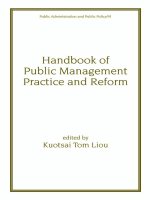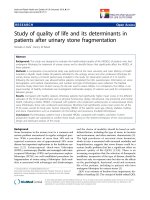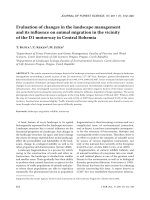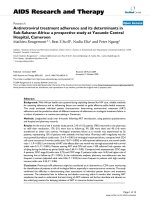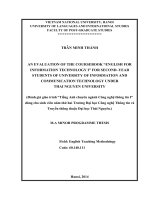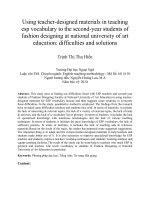MENSTRUAL HYGIENE MANAGEMENT PRACTICE AND ITS DETERMINANTS AMONG ADOLESCENT GIRLS IN SECOND CYCLE STUDENTS OF SEBETA TOWN, OROMIA, ETHIOPIA
Bạn đang xem bản rút gọn của tài liệu. Xem và tải ngay bản đầy đủ của tài liệu tại đây (1.35 MB, 67 trang )
ADDIS ABABA UNIVERSITY
COLLEGE OF HEALTH SCIENCES
SCHOOL OF PUBLIC HEALTH
A THESIS TO BE SUBMITTED TO ADDIS ABABA UNIVERSITY, COLLEGE OF
HEALTH SCIENCES, SCHOOL OF PUBLIC HEALTH; IN PARTIAL FULFILLMENT
FOR THE REQUIREMENT OF MASTERS DEGREE IN PUBLIC HEALTH
TITLE:
MENSTRUAL HYGIENE MANAGEMENT PRACTICE
AND ITS DETERMINANTS
AMONG ADOLESCENT GIRLS IN SECOND CYCLE STUDENTS OF SEBETA TOWN,
OROMIA, ETHIOPIA.
By: Abera Degefu (BA)
Advisor: Mirgissa Kaba (PhD)
June 2017
Addis Ababa
1
MENSTRUAL HYGIENE MANAGEMENT AND ITS DETERMINANTS AMONG
ADOLESCENT GIRLS IN SECOND CYCLE STUDENTS IN SEBETA TOWN, OROMIA,
ETHIOPIA
By: Abera Degefu (BA)
Advisor: Mirgissa Kaba (PhD)
June 2017
Addis Ababa, Ethiopia
ASSURANCE OF PRINCIPAL INVESTIGATOR
The undersigned agrees to accept responsibility for the scientific ethical and technical conduct of the
research project and for provision of required progress reports as per terms and conditions of the
Research Publications Office in effect at the time of Grant is forwarded as the result of this application.
Name of the student: _______________________________________
Date.____________________
Signature _________________
Approval of the primary Advisor
Name of the Primary Advisor:_________________________________
Date.____________________
Signature _________________
Name of investigator
Abera Degefu
Name of Advisor(s)
Mirgissa Keba(PHD)
Full title of the research project
MENSTRUAL HYGIENE MANAGEMENT AND ITS
DETERMINANTS AMONG ADOLESCENT GIRLS IN
SECOND CYCLE STUDENTS OF SEBETA TOWN,
OROMIA, ETHIOPIA
Duration of project
August 2016- January 2017
Study Area
Sebeta Town
Address of investigator
Tel: 0911 410832
Mail:
ii
Table of Contents
Table of Contents .............................................................................................................................................i
Acknowledgement ......................................................................................................................................... iii
Acknowledgement ......................................................................................................................................... iii
Acronyms and Abbreviations ......................................................................................................................... iv
List of Tables ................................................................................................................................................... v
List of Figures ................................................................................................................................................. vi
Abstract
................................................................................................................................................. vii
CHAPTER 1. Introduction ...............................................................................................................................1
1.1 Background ...........................................................................................................................................1
1.2 Problem Statement ...............................................................................................................................2
1.3 Rationale of the study ...........................................................................................................................3
CHAPTER 2. Literature Review .......................................................................................................................4
2.1 Awareness and attitude towards menstruation and its management .................................................4
2.2 Environmental determinants of menstrual hygiene management ......................................................5
2.3 Socio-economic determinants of menstrual hygiene management ....................................................5
CHAPTER 3. Objectives ..................................................................................................................................9
3.1 General Objective .................................................................................................................................9
3.2 Specific objectives .................................................................................................................................9
CHAPTER 4. Methods .................................................................................................................................. 10
4.1. Study Setting ..................................................................................................................................... 10
4.2 Study Design....................................................................................................................................... 10
4.3 Study period ....................................................................................................................................... 10
4.4 Population .......................................................................................................................................... 10
4.4.1. Source Population ...................................................................................................................... 10
4.4.2. Study Population ........................................................................................................................ 10
4.4.3. Study Units ................................................................................................................................. 10
4.5. Sampling Procedure .......................................................................................................................... 11
4.5.1. Sample Size ................................................................................................................................ 11
4.5.2. Sampling Technique ................................................................................................................... 11
4.5.3. Inclusion Criteria ........................................................................................................................ 13
4.5.4. Exclusion criteria ........................................................................................................................ 13
4.6. Measurement Variables .................................................................................................................... 13
i
4.6.1 Dependent Variable .................................................................................................................... 13
4.6.2 Independent variables ................................................................................................................ 13
4.7. Data Collection Procedures............................................................................................................... 13
4.8. Data Processing and Analysis ............................................................................................................ 14
4.9. Data Quality Management ................................................................................................................ 15
4.10. Ethical Consideration ...................................................................................................................... 15
4.11. Dissemination of Results ................................................................................................................. 16
4.13. Operational Definition .................................................................................................................... 16
CHAPTER 5. Result ...................................................................................................................................... 17
5.1 Background Characteristics of the Respondents ............................................................................... 17
5.2 Awareness and Communication about Menstruation and Menstrual Hygiene Management ......... 19
5.3 Determinants of Menstrual Hygiene Management Practice ............................................................. 21
5.4 Multivariable Analysis of Determinants of Menstrual Hygiene Management Practice .................... 25
CHAPTER 6. Discussion ............................................................................................................................... 28
CHAPTER 7. Conclusion and Recommendation .......................................................................................... 31
7.1 Conclusion.......................................................................................................................................... 31
7.2 Recommendation .............................................................................................................................. 31
References
Annex
Questionnaire
ii
Acknowledgement
I would like to express my gratitude to my thesis advisor Dr. Mirgissa Kaba. He was engaged
in the entire research process from the beginning by helping me in topic selection, research
proposal writing, and continuous monitoring of the thesis writing and forwarding invaluable
comments. His words have always inspired me to a higher level of thinking. What I learn from
my advisor is not only how to write research proposal to meet graduation requirements, but
also how to view things in different perspectives. I am also indebted to Dr. Asefa Seme, for
his continuous follow up from entry to the program until now and also for his gentle
introduction to research methodology.
iii
Acronyms and Abbreviations
AAU
ADDIS ABABA UNIVERSITY
AOR
ADJUSTED ODDS RATIO
CI
CONFIDENCE INTERVAL
COR
CRUDE ODDS RATIO
FGD
FOCUS GROUP DISCUSSION
MHP
MENSTRUAL HYGIENE PRACTICE
MHM
MENSTRUAL HYGIEN MANAGEMENT
ORHB
OROMIA REGIONAL HEALTH BEAREAU
SD
STANDARED DIVATION
SPSS
STATISTICAL PACKAGE FOR SOCIAL SCIENCES
UNICEF
UNITED NATION CHILDREN FUND
WASH
WATER, SANITATION AND HYGIENE
WHO
WORLD HEALTH ORGANIZATION
iv
List of Tables
Table 1: Background characteristics of in school adolescent girls, Sebeta 2017 ................................18
Table 2: Knowledge and communication about menstruation among in-school adolescent girls,
Sebeta 2017 ............................................................................................................................21
Table 3: Percent distribution of menstrual hygiene practice by socio-economic and demographic
characteristics of in-school adolescent girls, Sebeta 2017 .....................................................22
Table 4: School absenteeism and reasons for absence during menstruation of in-school girls,
Sebeta 2017 ............................................................................................................................23
Table 5: Percent distribution of menstrual hygiene practice by knowledge and attitude of inschool adolescent girls, Sebeta 2017 ......................................................................................24
Table 6: Result from Logistic Regression Analysis for Menstrual Hygiene Management Practice
among in-school adolescent girls, Sebeta 2017......................................................................27
v
List of Figures
Figure 1: Conceptual Framework of the Study ......................................................................................8
Figure 2: Sampling Procedure Scheme ................................................................................................12
Figure 3: Source of information about menstruation for in-school adolescents, Sebeta 2017 ............19
Figure 4: Source of information about menstrual hygiene for in-school adolescents, Sebeta 2017 ....20
Figure 5: Menstrual Hygiene Management Practices among in-School Adolescent Girls, Sebeta
2017. .......................................................................................................................................23
vi
Abstract
Background: Menstruation and menstrual practices are still clouded by socio-cultural
restrictions resulting in adolescent girls remaining ignorant of the scientific facts and hygienic
health practices.
Objective: The objective of this study was to assess menstrual hygiene management practice
among adolescent girls and its determinants in second cycle schools of Sebeta Town, Oromia
Regional State.
Materials and Methods: A school based cross-sectional study design was conducted among
466 in-school adolescent girls of grade 7 & 8 in Sebeta Town in December 2016. A singlestage cluster sampling was used to select the students for the present study. The outcome
variable for the present study was menstrual hygiene management practice among in-school
adolescents. Data management task was undertaken on EpiData 3.1 and analysis was done
using SPSS for windows version 21. Bivariate and multivariable logistic regressions analysis
were conducted to identify the determinant factors of menstrual hygiene practice of adolescent
female in-school students. A p-value of 5% was used as a cut off value to declare statistical
significance in this study.
Results: The proposed sample size for the present study was 485; however, a total of 466
adolescent female students participated in the study making the response rate 95.9%. The
prevalence of proper practice of menstrual hygiene management among in-school adolescent
girls was one in five (21.0%). Mothers were the major source of information about
menstruation before menarche and menstrual hygiene management as well. Young adolescent
girls who had a partial awareness about menstrual hygiene management practice [AOR=0.60
(0.36, 0.98)] and unfavorable attitude towards it [AOR=0.37, 95% CI : 0.22, 0.61] were less
likely to practice menstrual hygiene management.
Conclusion: The level of proper menstrual hygiene management practice among young
adolescent in-school girls is very low and large proportions do not properly wash and change
menstrual pad. Many adolescent girls miss school because they lack appropriate facilities
within school that allow for private management of their menstrual hygiene. Working on
awareness creation on menstrual hygiene management and making school environment
conducive to girls does greatly improve the menstrual hygiene management experience of
young adolescent girls.
vii
CHAPTER 1. Introduction
1.1 Background
Adolescence is the period of transition from childhood to adulthood. WHO defined
adolescence as the age group of 10-19 years. In girls, adolescence is recognized as an
unstable period which signifies the transition from girlhood to womanhood. A woman goes
through several developmental milestones that greatly influence her reproductive health.
Menarche, which is the establishment of menstruation, is one of those milestones and a
natural phenomenon unique to females (1). Moreover, menarche was a landmark feature of
female puberty and signals reproductive maturity (2). There were several traditions, myths,
misconceptions, mystery and
superstition prevailing about menstruation (3). Menstruation
was the cyclical shedding of the inner lining of the uterus, the endometrial, under the control
of hormones of the hypothalamus pituitary axis (1, 3). The first menstruation (menarche)
occurs between 11 and 15 years with a mean age of 13 years.
The study done in developing countries observed that lack of policy debate; action and
investments regarding menstrual hygiene and management were widespread in developing
countries (1). The lack of policy debates was mainly due to cultural issues especially in
Africa and Asia. The study recommended policy advocacy, investments and action, in terms
of education and improved facilities (such as gender- friendly toilets, and access to sanitary
pads) in order for adolescent girls and women to manage their menstrual needs adequately
(3).
Majority of the girls lack knowledge about menstruation and puberty. Adolescent girls often
are reluctant to discuss this topic with their parents and often hesitate to seek help regarding
their menstrual problems (1, 3). The profile of the woman's reproductive health is greatly
influenced by the girl's reaction to menarche, her beliefs and attitude towards menstruation,
and more importantly by her behavior during it (4). Girls need emotional support and
assurance that menstruation was normal and healthy, not bad, frightening or embarrassing
(5).
1
1.2 Problem Statement
It is estimated that around 52% of the females from all over the world (which approximates to
26% of the global population) belong to the reproductive age (6). Out of those, almost all
have regular menstrual cycle each month ranging from two to seven days in duration.
Although menstruation is a natural process of the female reproduction, it is always considered
as a taboo and people often feel shy to talk about it (7). Due to that reason, it becomes more
difficult for the girls to prepare for and follow the hygiene practices (8, 9).
Adolescence for girls is understood as an important milestone, marked by the onset of
menarche (10, 11). From adolescent to menopause, reproductive health and menstrual
hygiene are important aspects in the lives of women. However, not much attention is paid to
adolescent girls‟ specific needs; in general, not withstanding that doing so would lay a good
foundation for their physical and mental wellbeing and their ability to cope with the heavy
demands of reproductive health later in life (11, 12,13). Menstrual hygiene, that is, effective
management of menstrual bleeding by women and girls, if not managed properly can cause
urinary tract infection, pelvic inflammatory diseases and vaginal thrush as well as bad odor
due to these it imposes infringement on the girls‟ dignity (14).
In adolescents who experience menstruation for the first time, menstrual hygiene
management (MHM) is constrained by practical, social, economic and cultural factors such
as the expense of commercial sanitary pads, lack of water and latrine facilities, lack of private
rooms for changing sanitary pads, and low awareness about the facts of menstrual hygiene
[15]. During menstruation, adolescent girls face challenges related to the management of
menstrual hygiene in public places. UNICEF estimates that 1 in 10 school age African girls
do not attend school during menstruation. Similarly, the World Bank statistics indicate that
students will be absent from school 4 days every 4 weeks because of menstruation [16].
Despite such evidences of wide spread concern, there is no cross cultural study in Ethiopia in
addition in sub urban setting where awareness about sex is relatively better, menstrual
hygiene has not been studied. There is no study carried out to assess about preparation before
2
the onset of menstruation and management of it among adolescent girls in second cycle
schools of Sebeta. This study, therefore, attempts to assess the menstrual hygiene practice
among in school adolescent girls and its determinants in Sebeta Town.
1.3 Rationale of the study
Since there is inadequate information on menstrual hygiene among adolescent girls in Sebeta,
this study will identify issues relevant to preparation, practices, social and
challenges of
menstrual hygiene management and its determinants among adolescent girls. The study also
intends to identify necessary actions to be taken at local and regional levels through which
the menstrual hygiene problems of adolescent girls can be addressed. It is also hoped that the
findings from the study would generate further interest in the research field of reproductive
health and menstrual hygiene in the context of Sebeta Town.
3
CHAPTER 2. Literature Review
This chapter reviewed studies pertinent to preparation & management of menstrual hygiene
of adolescent girls of recently conducted researches in developing countries. A number of
globally conducted studies on reproductive health found that supporting menstrual hygiene
was vital for females in relation to Water Supply, Sanitation and Hygiene Education
(WASHE) (17). Following are review of related studies on menstrual hygiene management
and its determinant factors.
2.1 Awareness and attitude towards menstruation and its management
Access to adequate information on menstruation and reproductive health can help girls and
women in understanding their menstrual cycle and in relation to practicing proper menstrual
hygiene. This would enable females to live healthy, productive and dignified lives. The
studies also observed the necessity of girls and women having adequate access to clean water
for bathing and laundering of their menstrual paraphernalia, and space for drying such
materials. They also need privacy for changing sanitary napkins and proper facilities to
dispose of them (11, 17-19).
A study in done in India show that 60% of women dealt with menstruation unhygienically
(20). A statistically significant association was seen between menstrual hygiene management
and knowledge prior to menarche, type of protection, access to water, bathroom facilities and
menstrual disorders. It also showed that unhygienic menses and reproductive tract and skin
infection (20). Other studies report inadequate or lack of knowledge about menstruation and
consequently, poor menstrual hygiene practices among adolescent girls (1, 5, 10, 11, 21). A
cross-sectional study undertaken in West Bengal with 160 respondents reports that the
majority of the girls did not fully understand the physical process of menstruation hence were
not prepared for their first period. The study further highlights that many girls were ignorant
of scientific facts about menstruation and proper hygienic practices (22).
A cross-sectional study conducted in Nepal & India on adolescent girls in four government
secondary schools about girls‟ level of knowledge of the physiological and psychological
processes of menstruation reported inadequate knowledge of the process of menstruation
4
among the respondents, and revealed that the girls‟ perceptions were mainly influenced by
cultural beliefs (1, 7).
2.2 Environmental determinants of menstrual hygiene management
Studies conducted in developing countries showed that lack of policy debate, action and
investments regarding menstrual hygiene and management were widespread in developing
countries (1). The lack of policy debates was mainly due to cultural issues especially in
Africa and Asia. The study recommended policy advocacy, investments and action, in terms
of education and improved facilities (such as gender- friendly toilets, and access to sanitary
pads) in order for adolescent girls and women to manage their menstrual needs adequately
(3).
The above complies with the findings of previously quoted study of menstrual hygiene and
management of school going girls in Malawi. The study reported that poor menstrual hygiene
and management in schools in Malawi contributes to girls‟ high rates of absenteeism and
poor performance (23). In the same study it was also observed that the sanitation facilities
and infrastructures for girls in all schools were inadequate as they do not meet the required
minimum standard ratio of 1:30 for toilets as suggested by World Health Organisation (5).
Add to this that similar findings on lack of or inadequate facilities were also reported in a
cross-sectional study done in Egypt among adolescent school girls (16). Ninty seven percent
of the study participants complained about lacking facilities and privacy in schools for
disposal and changing of pads. Only 6.7% of the participants reported that they changed pads
in school (24).
2.3 Socio-economic determinants of menstrual hygiene management
A descriptive study undertaken at Isra University Hyderabad in India to determine knowledge
and different attitudes towards menstruation among local young women, indicated that
adolescent girls, compared to their age mates in Western societies, were not prepared for the
menstrual process. The study revealed that the girls responded very emotionally when they
were faced with their first period; about 53% of them felt embarrassed. The study
5
recommended early education about menstruation before puberty to prepare the girls
emotionally (25).
Studies undertaken in Nepal and South India, specifically underline the importance of socioeconomic factors and their direct influence on girls‟ knowledge of reproductive health and
their menstrual hygiene practices. Those girls whose parents or families were highly educated
and well off had better knowledge and awareness. The higher the family income, the more
knowledgeable were the family female members about the various aspects of reproductive
health and menstrual hygiene and therefore applied better practices than girls from low class
families (11). The study undertaken in India coincides with yet another study done in India by
reporting similar findings. There was a case in which a large majority of the participants
(about 98%) reported practicing poor hygiene which was clearly due to inadequate
knowledge, limited water supply and inadequate sanitary pads, which again could be
associated with low income (21). The links between low income/low social status and lack of
knowledge, leading to poor menstrual hygiene practices, and correspondingly between high
income/high social status and good knowledge, leading to proper menstrual hygiene, is also
disclosed in a very recent study from Sokoto in Nigeria (14).
A study conducted in Ethiopia on Age of Menarche and Knowledge about Menstrual
Hygiene Management among Adolescent School Girls in Amhara Region of Ethiopia using
cross-sectional design on 492 students shows that 446 (90.7%) of the respondents had high
level knowledge about menstrual hygiene management. According to the study, factors
associated with knowledge about menstrual hygiene management were place of residence
(being urban) and educational status of their mothers (26).
A study conducted on Menstrual hygiene management and school absenteeism among female
adolescent students in Northeast Ethiopia by using
mixed-method research combining
quantitative and qualitative shows that 51% of girls had knowledge about menstruation and
its management. Moreover, knowledge and income of mothers the main factors for awareness
of girls and on school absenteeism (27). Similarly, a school based cross-sectional study
design was done in
Nekemte Town, Western Ethiopia
shows
60.9 % and 39.9 %
6
respondents had good knowledge and practice of menstrual hygiene, respectively. The
findings of the study showed a significant positive association between good practices of
menstruation and educational status of mothers (AOR = 1.51, 95 % CI = 1.02 – 2.22) (28).
In general, ignorance of or being unable to apply proper means of menstrual hygiene has a
negative impact on the physical and mental wellbeing of girls, as well as their educational
opportunities in developing countries (18). Improving girls‟ menstrual hygiene practices and
providing more insight in the female reproductive cycle are hence of paramount importance
(7). The above studies confirm the value of adequate information, and further, the fact that
knowledge can influence attitudes towards good hygiene, behavioural practices and proper
menstrual hygiene significantly. Therefore, it was very important to prepare adolescent girls
prior to menarche sufficiently by educating them on menstruation and menstrual hygiene.
Thus, identifying the determinant factors of menstrual hygiene management of early
adolescent girls would be of paramount importance in order to prepare them for the hygienic
management of their menstruation. As a result, this study attempted to identify the various
determinant factors associated with menstrual hygiene management of early adolescent inschool girls. Based on the above literatures reviewed, a conceptual framework was developed
and displayed below.
7
Conceptual framework
Environmental Factors
Availability of and access to
separate latrine for girls
Availability of and access to
water in school
Socio-economic factors
Religion
Educational status of parents
Occupation of parents
Menstrual hygiene
Management practice
Awareness & Attitude
Awareness about menstrual
hygiene practice
Attitude towards menstrual
hygiene practice
Access to information regarding
menstrual hygiene practice
Figure 1: Conceptual Framework of the Study Adopted after Reviewing Related Literature
8
CHAPTER 3. Objectives
3.1 General Objective
The main objective of this study was to assesses menstrual hygiene management among
adolescent girls and its determinants in second cycle of Sebeta Town, Oromia Ethiopia 2016.
3.2 Specific objectives
Specifically, the study aims to
To assess the level of menstrual hygiene management practice among in-school
adolescent girls
To assess socio-economic determinants of menstrual hygiene management practice of
adolescent girls.
determine environmental determinants of menstrual hygiene management practice of
adolescent girls
9
CHAPTER 4. Methods
4.1. Study Setting
The study was conducted in Sebeta Town Oromia Region which is located 25 km away from
Finfine in South West direction. The Town has an area of 17.62 sq. km comprising of 9
Kebeles. The Town is conducive for investment and hosts various small and big industries.
The projected total population of the Town in 2008 E.C. was 151,580 as municipality annual
report shows (30). Different ethnic groups living in the Town and the population uses variety
of languages of which are Afaan Oromo, Amharic & other. There were a total of 104 schools
from elementary to high school. From these, 18 schools are government and the rest 86 were
privately owned with a total of 38,003 students registered in the current academic year. With
regard to health facilities, there are 4 government functional health center, 51 medium private
clinics and 4 drug vendors. (30)
4.2 Study Design
A school based cross-sectional study design was conducted among in-school adolescent girls
of grade 7 & 8 in Sebeta Town.
4.3 Study period
The data collection was conducted during the period of December 07-17, 2016.
4.4 Population
4.4.1. Source Population
The source population was female students of second cycle in Sebeta Town who reached at
the start of menarche.
4.4.2. Study Population
Adolescent girls who are regular students enrolled in grade seven and eight in all the eight
governmental schools of Sebeta Town during the 2016/17 academic year.
4.4.3. Study Units
Adolescent girl student enrolled in grade 7 or 8 in Sebeta Town are the study units.
10
4.5. Sampling Procedure
4.5.1. Sample Size
The sample size was determined using the single population proportion formula for menstrual
hygiene management. That is, proportion of students with an appropriate menstrual hygiene
management practice (35.4%) (29), 5% margin of error (d), a 95% confidence interval
(Z=1.96), a 10% non-response rate and a design effect of 1.5 was assumed. Furthermore,
since the population size is less than 10,000 a finite population correction (The total number
of students in all the 8 schools are N=1628) was made on the sample size. Considering the
above assumption, the initial sample size, no, was calculated as shown below:
𝑛𝑜 =
𝑍2
1.962
𝑑
0.052
2×𝑃 1−𝑃 =
× 0.354 1 − 0.354 = 352
After finite population correction, nf, becomes
𝑛𝑓 =
𝑛𝑜
352
≈ 290
𝑛𝑜 =
1 + 𝑁 1 + 352
1628
Adjusting for non-response and design effect, the final sample size will be
𝑛 = 1.5 ×
𝑛𝑓
290
= 1.5 ×
≈ 485
0.9
0.9
4.5.2. Sampling Technique
A rapid assessment survey was conducted before data collection to get the exact number of
adolescent girl students from each selected schools. This rapid assessment was made to
identify total number of sections and second cycle adolescent girl students by school, grade
and section. The students were selected by using a single stage cluster sampling
technique. There are 1628 girl students in these 8 schools. In the first stage of
sampling, five schools were selected using probability proportion to size sampling
technique. The schools were „Mulugeta Gedle‟, „Alemgena‟, „Rogee‟, „Karabu‟, and
„Dima Guranda‟. Secondly, proportional allocation was used to distribute the sample
over the five schools. Further, the sample allocated for each school was distributed
proportionally first to grades 7 & 8 and then to sections under each of the grades.
Finally, simple random sampling was employed to select students from each section
using classroom attendance in collaboration with home room teachers of respective classes.
11
8 Schools
Mulugeta Gedle, Alemgena, Rogee, Karabu, Dima
Guranda, Dima M, Hatebela and Daleti
PPS
PPS
(Hosting 1628 adolescent female students in the current FY)
PPS
Mulugeta Gedle
(114)
Proportional
Allocation
Grade 7
(55)
Alemgena
(72)
Proportional
Proportional Allocation
Allocation
Grade 8
(59)
Grade 7
(36)
PPS
PPS
Rogee
(123)
Proportional
Allocation
Proportional
Allocation
Grade 8
(36)
Grade 7
(64)
Karabu
(129)
Proportional
Allocation
Proportional
Allocation
Grade 8
(59)
Grade 7
(70)
Dima Guranda
(47)
Proportional
Allocation
Proportional
Allocation
Proportional
Allocation
Grade 8
(59)
Grade 7
(23)
Grade 8
(24)
2 Sections
2 Sections
Proportional allocation of the respective grade sample sizes to section sizes
4 Sections
4 sections
1 Section
1 Section
3 Sections
4 Sections
3 Sections
3 Sections
Figure 2: Sampling Procedure Scheme
12
4.5.3. Inclusion Criteria
All adolescent girls of grade 7 and 8 found in selected schools of Sebeta Town.
4.5.4. Exclusion criteria
Adolescent girls those have hearing and sight problems
4.6. Measurement Variables
4.6.1 Dependent Variable
Menstrual hygienic practice: when adolescent girls use a clean material to absorb or collect
menstrual blood and this material can be changed in privacy as often as necessary for the
duration of the menstrual period.
4.6.2 Independent variables
Age of a student,
Grade
Educational status of mother and father,
Religion
Knowledge about menstrual hygiene management
Attitude of adolescent girls towards menstrual hygiene management
Availability of and access to water and
Availability of and access to separate latrine for female
4.7. Data Collection Procedures
The overall data collection process was coordinated and supervised by hired supervisors, data
collectors and the principal investigator. A total of 10 female teachers from the selected schools,
two in each school, 5 supervisors one from each school, who were fluent speaker of Amharic and
Afaan Oromo and well versed in the culture of the community were recruited to assist the
13
research process and supervise the data collection process. They were given a briefing about the
objective of the research and were trained for one day on the content of the questionnaire. The
questionnaire was pre-tested on 30 students at Keta Junior School of Burayu Town. The
feedback from the pretest was used to edit the wording of terms in the local language and
sequencing of some questions.
The data collectors gathered the selected students from each section, one for grade 7 and one for
grade 8, of a given school in one class for ease of data collection and distributed the
questionnaire to the students. An orientation about the research objective was given to the
students before filling out the questionnaire and clarification was also given by the supervisors
for questions that were raised by the students on personal basis. Finally, the collected data was
reviewed for completeness and consistency by the supervisors and the principal investigator on
daily basis.
4.8. Data Processing and Analysis
Data was entered, cleaned and prepared for analysis using EpiData 3.1 and exported to SPSS for
windows version 21 for analysis. Percentages, frequencies, chart, and cross tabulations were used
to describe the major characteristics of respondents. Further, bivariate and multivariable logistic
regressions analysis was conducted to identify the determinant factors of menstrual hygiene
practice of adolescent female in-school students. A Bivariate analysis was used to identify
candidate variables for the multivariable analysis. A 20% p-value was used in the bivariate
analysis in order not to miss potential variables early from the multivariate analysis. Crude Odds
Ratio (COR) and Adjusted Odds Ratio (AOR) were the effect measures of association used in
the analysis to identify the predictors of menstrual hygiene management practice. A p-value of
5% was used as a cut off to declare statistical significance in multivariable analysis for this
study.
14
